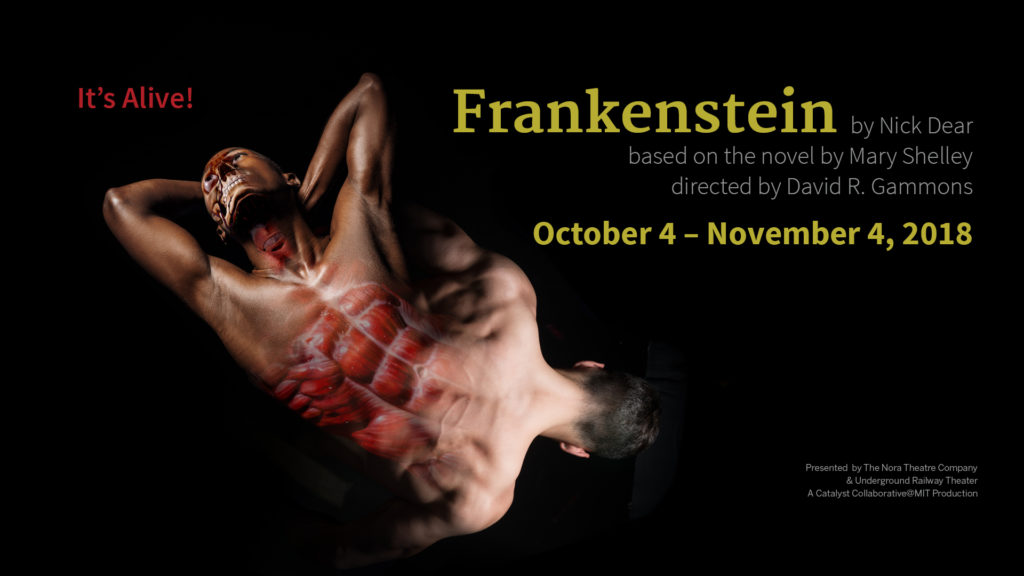
Produced by The Nora Theatre Company & Underground Railway Theater; A Catalyst Collaborative@MIT Production; Design by Bird Graphics.
Presented by Central Square Theater
Produced by The Nora Theatre Company & Underground Railway Theater
By Nick Dear
From the novel by Mary Shelley
Directed by David R. Gammons
Dramaturgy by Hilary Rappaport
Ensemble: Remo Airaldi, Omar Robinson, John Kuntz, Ashley Risteen, David Keohane, Debra Wise
Oct. 4 – Nov. 4, 2018
Central Square Theater
Cambridge, MA
CST on Facebook
Trigger warning: rape, violence, body horror, strobe effects, spoilers
Critique by Kitty Drexel
(Cambridge, MA) Prometheus stole fire from Mount Olympus and gave it to mankind. For his indiscretion, Zeus condemned the Titan to an eternity of epic liver failure (a complication of eagle hunger). Shelley’s novel Frankenstein; or, The Modern Prometheus warns a relatively modern audience not to play with fire lest one get burned. It plays out similarly in contemporary Halloween favorites such as The Rocky Horror Show and Prometheus that frustrating movie by Ridley Scott. It takes new form as Central Square Theater’s current production. As long as there is science, there will be humans poking around where they shouldn’t be poking.
Frankenstein takes on Shelley’s novel as short form, postmodern, horror theatre. The small cast plays an assortment of roles in addition to jointly playing the Creature. Nick Dear’s adaptation is mostly well written for today’s audiences. It features both female and male central characters. Significant plot points from the original text are highlighted while also enlightening the audience to its necessary philosophic themes. Anyone can fulfill roles in the ensemble and the play still functions. There is only one huge drawback to this script: the Delacy face touching scene.
Delancey wouldn’t want to touch the Creature’s face. This is creepy, Hollywood “magic” bestowed on the seeing by terrible screenwriters who have never discussed a blind person’s experience with an actual blind person. Blind people don’t “see” faces by touching them. The seeing impaired community doesn’t want to touch you. They definitely don’t want to be touched by you. Please, for the love of Belgian waffles, leave them alone. Lionel Richie lied to us. He lied to us all.
Frankenstein the best ensemble work I’ve seen all year. The cast works together as a unit to deliver expressions of pure nascience. The first twenty to thirty minutes after the Creature’ rebirth into the world present him to us as a monosyllabic biped without grasp of speech or human experience. Ze is a foundering juvenile in a world of bright lights and shocking noises. It may take some unexpecting audience members some time to acclimate to the oddity of motion and sound. There is clear established trust and even affection between cast members as they work through the production. Frankenstein’s recollection of modern dance and mime is strange to the unexpecting eye but well performed.
Gammons plays delightfully with the script. He and Dear subvert Shelley’s original text to shine a light on topical identity politics. The Creature’s physical journey is also a spiritual journey to discover zir’s autonomous self beyond the Scientist’s study. The infamous rape scene is played between two women, one of whom declares zir’s toxic masculinity with the words, “now I am a man.” Another scene has Robinson scream, “I am not a slave,” into Kuntz’s face. Both scenes are woven into the normalcy of the play’s reality. It’s refreshing that Gammons took the opportunity to showcase such acts.
Cristina Todesco’s set with Rachel Padula’s costumes make Central Square Theater look like 90’s Industrial night at Man Ray. It’s a hyper-tactile raver’s paradise in neons and Plexiglas.
As engaging as the actor’s set was, the audience environment wasn’t. Central Square Theater is usually more attuned to audience ability needs but not for this production. Seating is divided into two tall risers. Each riser has only one aisle with approximately 10 to 15 chairs per row. Early arrivals near the mouth of the row, near the stairs had to remain standing for others to enter and exit the narrow seating areas until everyone in the row was seated. Younger audience members vaulted the rows to get to their seats. Seniors had to either remain standing or subject themselves to others scooting through their personal space. Those of us aged between were merely uncomfortable. A second row on the opposite side would uncomplicate navigational issues.
The singular set of stairs up each row wasn’t glowtaped. A man who walked with a cane nearly fell. CST’s accessibility level is usually quite high. This production falters.
Frankenstein is about a young, rich, white guy who’s shocked and confused when his scientific shenanigans go horribly awry. It’s an important lesson that we keep relearning. In this case, it’s played out with mime, dance and dialogue in graphic horror. Until we truly learn to let the spark of life be, productions like Frankenstein will continue to be timely.
Running time for Frankenstein is one hour, forty-five minutes with no intermission.
